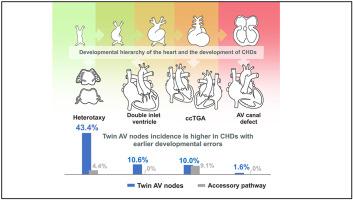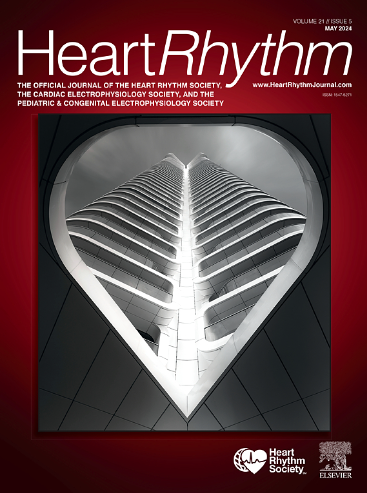Twin atrioventricular nodes and accessory pathways in congenital heart diseases with abnormal atrioventricular connections: Association with the developmental hierarchy of cardiac morphology
IF 5.7
2区 医学
Q1 CARDIAC & CARDIOVASCULAR SYSTEMS
引用次数: 0
Abstract
Background
Twin atrioventricular (AV) nodes (TWAVNs) are common in heterotaxy syndrome.
Objective
The purpose of this study was to investigate the presence and implications of TWAVNs and accessory pathways in congenital heart diseases (CHDs) with abnormal AV connections.
Methods
A retrospective study of a 1980–2022 cohort with sufficient electrocardiographic (ECG) data for review was conducted.
Results
We enrolled 136 patients with heterotaxy syndrome, 70 with congenitally corrected transposition of the great arteries (ccTGA) (4 with Ebstein anomaly), 47 with double-inlet ventricle (DIV), and 63 with isolated AV canal defect. TWAVNs, detected in the same ECG (18%), in separate ECGs (70.8%), or after electrophysiological study (11.2%), were present in 43.4% of heterotaxy, 10.6% of DIV, 10% of ccTGA, and 1.6% of AV canal defect cases. Accessory pathways were noted in 11.4% of ccTGA and 4.4% of heterotaxy cases, but none of the DIV and AV canal cases. Actuarial incidence of supraventricular tachycardia (SVT) by age 10 was 0.354, 0.121, 0.022, and 0 in heterotaxy, ccTGA, DIV, and AV canal, respectively. In patients with TWAVNs, the risk of SVT varies according to the rate of TWAVNs in each CHD type, with risks of 65.5%, 58.3%, and 0% for TWAVNs rates >50%, 10%–50%, and <10%, respectively. Onset age of tachycardia did not differ between those with TWAVNs and those with accessory pathways.
Conclusion
In CHD with abnormal AV connections, evidence suggested a developmental hierarchy in the propensity to exhibit TWAVNs, but not for accessory pathways. The earlier cardiac developmental errors occur, the higher the likelihood of TWAVNs and the greater the chance of SVT.

先天性心脏病中伴有异常房室连接的双房室结和附属通路:与心脏形态发育层次的关联。
背景:双房室结(TWAVNs)在异位综合征中很常见:研究双房室结和附属通路在房室连接异常的先天性心脏病中的存在及其影响:方法:对1980-2022年的队列进行回顾性研究,并提供足够的心电图数据供审查:我们纳入了 136 例异位综合征患者、70 例先天性大动脉转位矫正术(ccTGA,4 例 Ebstein 异常)患者、47 例双入口心室(DIV)患者和 63 例孤立房室管缺损患者。在同一心电图(18%)、单独心电图(70.8%)或电生理研究后(11.2%)发现的双侧房室缺损网出现在 43.4% 的异位、10.6% 的 DIV、10% 的 ccTGA 和 1.6% 的房室管缺损病例中。在 11.4% 的 ccTGA 和 4.4% 的异位病例中发现了辅助通路,但在 DIV 和房室管缺损病例中没有发现辅助通路。到 10 岁时,异位、ccTGA、DIV 和房室管缺损患者室上性心动过速 (SVT) 的精算发生率分别为 0.354、0.121、0.022 和 0。在有 TWAVNs 的患者中,SVT 的风险根据每种 CHD 类型中 TWAVNs 的比率而变化,TWAVNs 比率>50%、10-50% 和结论的风险分别为 65.5%、58.3% 和 0%:在房室连接异常的先天性心脏病中,有证据表明出现 TWAVNs 的倾向具有发育层次性,但附属通路则无此倾向。心脏发育错误发生得越早,出现 TWAVNs 的可能性就越高,发生 SVT 的几率也越大。
本文章由计算机程序翻译,如有差异,请以英文原文为准。
求助全文
约1分钟内获得全文
求助全文
来源期刊

Heart rhythm
医学-心血管系统
CiteScore
10.50
自引率
5.50%
发文量
1465
审稿时长
24 days
期刊介绍:
HeartRhythm, the official Journal of the Heart Rhythm Society and the Cardiac Electrophysiology Society, is a unique journal for fundamental discovery and clinical applicability.
HeartRhythm integrates the entire cardiac electrophysiology (EP) community from basic and clinical academic researchers, private practitioners, engineers, allied professionals, industry, and trainees, all of whom are vital and interdependent members of our EP community.
The Heart Rhythm Society is the international leader in science, education, and advocacy for cardiac arrhythmia professionals and patients, and the primary information resource on heart rhythm disorders. Its mission is to improve the care of patients by promoting research, education, and optimal health care policies and standards.
 求助内容:
求助内容: 应助结果提醒方式:
应助结果提醒方式:


